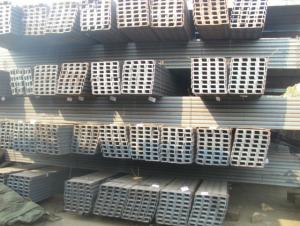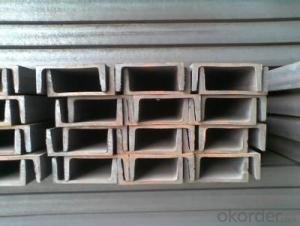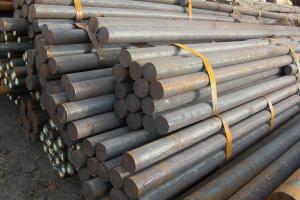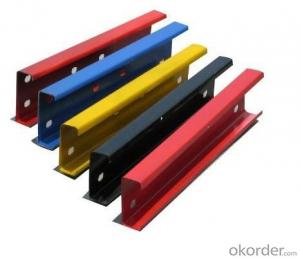GB Q345 Steel Channel
- Loading Port:
- China Main Port
- Payment Terms:
- TT OR LC
- Min Order Qty:
- -
- Supply Capability:
- -
OKorder Service Pledge
OKorder Financial Service
You Might Also Like
Product Description:
Specifications of MS Channel:
1.We supply high quality MS Channel at reasonable price, including Chinese standard, Japanese standard and so on.
Standard | GB |
Material Grade | Q2345 |
Technique: | Hot Rolled |
Sizes as per chinese standard: | 50*37*4.5mm - 300*89*11.5mm
|
Sizes as per japanese standard: | 50*25*3mm – 200*80*7.5mm |
Length: | 6meter, 9meter, 12meter |
Note: 1.we are also competent to provide our customers other MS Channel based on other sizes according to customer’s requirements.
2. The length of our ms channel could be cut into other meters as per customer’s requirements. For example, the channel in 6meters could be cut into 5.8meters in order to be fit in the 20ft container.
2. The detailed sections of MS Channel as per GB standard.are shown in the table-1:
GB U CHANNEL | Standard | Sectional | Dimension |
| Mass: |
| (mm) | (mm) | (mm) | (mm) |
|
50X37 | 50 | 37 | 4.50 | 7.0 | 5.438 |
63X40 | 63 | 40 | 4.80 | 7.5 | 6.634 |
80x43 | 80 | 43 | 5.00 | 8.0 | 8.045 |
|
|
|
|
|
|
100x48 | 100 | 48 | 5.30 | 8.5 | 10.007 |
120x53 | 120 | 53 | 5.50 | 9.0 | 12.059 |
140x58 | 140 | 58 | 6.00 | 9.5 | 14.535 |
140x60 | 140 | 60 | 8.00 | 9.5 | 16.733 |
|
|
|
|
|
|
160x63 | 160 | 63 | 6.50 | 10.0 | 17.240 |
160x65 | 160 | 65 | 8.50 | 10.0 | 19.752 |
|
|
|
|
|
|
180x68 | 180 | 68 | 7.00 | 10.5 | 20.174 |
180x70 | 180 | 70 | 9.00 | 10.5 | 23.000 |
|
|
|
|
|
|
200x73 | 200 | 73 | 7.00 | 11.0 | 22.637 |
200x75 | 200 | 75 | 9.00 | 11.0 | 25.777 |
|
|
|
|
|
|
220x77 | 220 | 77 | 7.00 | 11.5 | 24.999 |
220x79 | 220 | 79 | 9.00 | 11.5 | 28.453 |
|
|
|
|
|
|
250x78 | 250 | 78 | 7.00 | 12.0 | 27.410 |
250x80 | 250 | 80 | 9.00 | 12.0 | 31.335 |
250x82 | 250 | 82 | 11.00 | 12.0 | 35.260 |
|
|
|
|
| |
280x82 | 280 | 82 | 7.50 | 12.5 | 31.427 |
280x84 | 280 | 84 | 9.50 | 12.5 | 35.823 |
280x86 | 280 | 86 | 11.50 | 12.5 | 40.219 |
|
|
|
|
|
|
300x85 | 300 | 85 | 7.50 | 13.5 | 34.463 |
300x87 | 300 | 87 | 9.50 | 13.5 | 39.173 |
300x89 | 300 | 89 | 11.50 | 13.5 | 43.883 |
Table-1
Note: we are able to present our customers relevant SGS test report for chemical composition of HR Channel Steel.
Applications of MS Channel:
The MS Channel can be applied to construction of warehouses, workshops, sport stadiums and car parks etc.The hot rolled channel steel belongs to carbon structural steel which is applied to in the field of construction and machinery.In details, the hot rolled channel steel is usually used for arch-itechtural structure, and they could be welded in order to support or hang a vari-ety of facilities. They are also usually used in combination with I beam. Generally,the hot rolled channel steel we supply must possess perfect welding property, riveting property and mechanical property and so on.
Package & Delivery of MS Channel:
1.The hot rolled channel steel will be packed in bundle with steel wire at each end of every bundle and color marking in order to help the customer to recognize his goods more easily at sight.
2. And the hot rolled channel steel could be loaded into 20ft or 40ft container, or by bulk cargo.If the weight of each bundle reaches more than 3.5 mt, the loading by break bulk cargo should be choosed.When the weight of each bundle reaches less than 3mt, the loading by container should be choosed.
3.As for the transportaion from mill to loading port, the truck will be usually used. And the maximum quantity for each truck is 40mt.
4.All in all, we could do in accordance with customer's request.
- Q: Can steel channels be used for partition walls?
- Indeed, partition walls can indeed be constructed using steel channels. In the realm of construction, steel channels are widely favored due to their robustness and resilience. They furnish a solid framework for partition walls and adeptly bear the load of wall finishes, be it drywall or plasterboard. It is worth noting that steel channels offer the added benefit of being fire-resistant, thereby bolstering the partition wall's structural soundness. Moreover, the employment of steel channels affords ample room for creativity and personalization in design, rendering them fitting for a plethora of applications in both residential and commercial ventures.
- Q: Are steel channels prone to rusting?
- Indeed, rusting is a common issue with steel channels. Given that steel is predominantly comprised of iron, its exposure to moisture or oxygen prompts a chemical reaction called oxidation, resulting in the formation of rust. As rust weakens the steel structure, it becomes more prone to corrosion and eventual collapse. Consequently, it is imperative to shield steel channels from moisture and other corrosive substances through the use of suitable coatings or treatments in order to prevent rust formation and extend their longevity.
- Q: Can steel channels be used for machinery support?
- Yes, steel channels can be used for machinery support. Steel channels are commonly used in construction and engineering applications due to their strength and durability. They are widely used as support structures for heavy machinery, providing stability and ensuring the safe operation of the equipment. Steel channels are capable of withstanding heavy loads and can be designed to meet specific weight requirements. Additionally, they can be easily fabricated and installed, making them a practical choice for machinery support.
- Q: Channel structure, angle steel, I-beam and so on, if not painted, the impact on life?
- The influence will reduce the life span
- Q: What is the weight-bearing capacity of steel channels?
- The weight-bearing capacity of steel channels varies depending on their dimensions, thickness, and quality. It can range from a few hundred pounds to several tons, making them suitable for a wide range of structural applications.
- Q: What are the different types of connections used for steel channels in curtain wall systems?
- There are several types of connections used for steel channels in curtain wall systems. Some common types include welded connections, bolted connections, and clip connections. Welded connections involve joining the steel channels together using welding techniques. Bolted connections involve using bolts and nuts to secure the channels together. Clip connections use specialized clips that attach to the steel channels, providing a secure connection. These different types of connections offer varying levels of strength, flexibility, and ease of installation, depending on the specific requirements of the curtain wall system.
- Q: What are the different design codes and standards for steel channels?
- There are several design codes and standards that specifically address steel channels. These codes and standards provide guidelines for the design, fabrication, and installation of steel channels to ensure structural integrity and safety. One widely recognized design code for steel channels is the American Institute of Steel Construction (AISC) Specification for Structural Steel Buildings. This code provides comprehensive guidelines for the design, detailing, and construction of steel structures, including channels. It covers topics such as permissible stress design, load combinations, and design requirements for connections. In addition to the AISC Specification, there are other design codes and standards that may be applicable to steel channels, depending on the specific application. For instance, the American Society of Civil Engineers (ASCE) 7-16 Minimum Design Loads and Associated Criteria for Buildings and Other Structures provides guidelines for determining design loads, which are important considerations in designing steel channels. Another relevant standard is the ASTM A36/A36M specification, which sets the requirements for carbon structural steel, including steel channels. This standard covers the chemical composition, mechanical properties, and other specifications for carbon steel materials. Furthermore, the International Building Code (IBC) is a model code that is widely adopted and enforced in many countries. It includes provisions for the design and construction of steel structures, including channels, ensuring compliance with safety and performance requirements. It is important to note that design codes and standards may vary depending on the country or region. Therefore, it is crucial to consult the applicable local codes and standards when designing and constructing steel channels. Overall, the different design codes and standards for steel channels provide engineers and designers with the necessary guidelines and requirements to ensure the safe and efficient design of steel channel structures. These codes and standards address various aspects, such as load calculations, material specifications, design methodologies, and construction practices, to ensure the structural integrity and safety of steel channels.
- Q: How are steel channels connected to other structural elements?
- Steel channels can be connected to other structural elements through various methods such as welding, bolting, or using structural connectors. These connections ensure stability and integrity in the overall structure by providing secure attachment points between the steel channels and other components.
- Q: How are steel channels used in structural applications?
- Steel channels are commonly used in structural applications as they provide structural support and stability. They are often used as beams or columns to carry heavy loads and distribute weight evenly. Steel channels can also be used as stiffeners to strengthen and reinforce structures. Their versatility and durability make them essential components in construction projects, ranging from buildings and bridges to industrial plants and infrastructure.
- Q: Can steel channels be used for wall framing?
- Yes, steel channels can be used for wall framing. Steel channels, also known as C-channels or U-channels, are commonly used in construction for various purposes, including wall framing. They provide strength and stability to the structure while allowing for flexible design options. Steel channels are often preferred over traditional wood framing due to their durability, resistance to warping or shrinking, and fire resistance properties. They are also lightweight and can be easily installed, making them a popular choice in modern construction practices.
Send your message to us
GB Q345 Steel Channel
- Loading Port:
- China Main Port
- Payment Terms:
- TT OR LC
- Min Order Qty:
- -
- Supply Capability:
- -
OKorder Service Pledge
OKorder Financial Service
Similar products
Hot products
Hot Searches
Related keywords


























